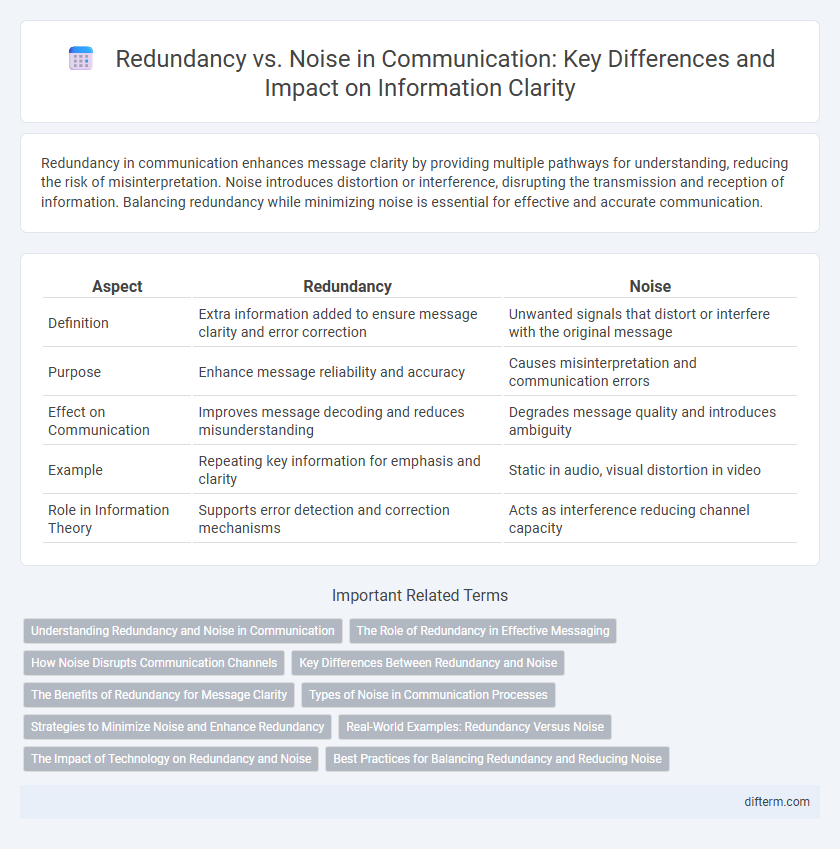Redundancy in communication enhances message clarity by providing multiple pathways for understanding, reducing the risk of misinterpretation. Noise introduces distortion or interference, disrupting the transmission and reception of information. Balancing redundancy while minimizing noise is essential for effective and accurate communication.
Table of Comparison
| Aspect | Redundancy | Noise |
|---|---|---|
| Definition | Extra information added to ensure message clarity and error correction | Unwanted signals that distort or interfere with the original message |
| Purpose | Enhance message reliability and accuracy | Causes misinterpretation and communication errors |
| Effect on Communication | Improves message decoding and reduces misunderstanding | Degrades message quality and introduces ambiguity |
| Example | Repeating key information for emphasis and clarity | Static in audio, visual distortion in video |
| Role in Information Theory | Supports error detection and correction mechanisms | Acts as interference reducing channel capacity |
Understanding Redundancy and Noise in Communication
Redundancy in communication enhances message clarity by repeating key information, which helps receivers accurately decode content despite potential interference. Noise refers to any disturbance or distortion, such as background sounds or technical glitches, that disrupts effective transmission of the message. Balancing redundancy minimizes the impact of noise, ensuring clearer understanding and stronger information retention.
The Role of Redundancy in Effective Messaging
Redundancy in communication enhances message clarity by reinforcing key information, reducing the likelihood of misinterpretation caused by noise such as signal distortion or background interference. It ensures the receiver accurately decodes the intended meaning, improving message reliability in environments with high noise levels. Effective messaging leverages redundancy techniques like repetition and paraphrasing to maintain comprehension despite potential disruptions.
How Noise Disrupts Communication Channels
Noise disrupts communication channels by introducing interference that distorts or obscures the intended message, leading to misunderstandings and reduced information clarity. Unlike redundancy, which reinforces the message to ensure accurate reception, noise creates barriers that impede effective information transfer. Persistent noise in communication systems lowers signal quality, increases error rates, and hampers both verbal and nonverbal exchanges, resulting in communication breakdowns.
Key Differences Between Redundancy and Noise
Redundancy in communication refers to the intentional repetition or inclusion of extra information to ensure message clarity and accuracy, whereas noise represents any unwanted interference that distorts or disrupts the transmission of the message. Unlike noise, which degrades communication effectiveness by causing misunderstandings or data loss, redundancy enhances reliability by providing backup cues that help receivers interpret the message correctly. Understanding the key difference highlights redundancy as a positive strategy to combat the negative impact of noise on communication channels.
The Benefits of Redundancy for Message Clarity
Redundancy enhances message clarity by providing multiple ways to convey the same information, reducing the risk of misunderstanding. In communication systems, including verbal and digital formats, redundancy acts as a safeguard against noise interference that can distort or obscure the original message. This layered approach ensures the receiver accurately interprets the intended meaning despite potential disruptions.
Types of Noise in Communication Processes
Types of noise in communication processes include physical noise, such as background sounds and environmental distractions; psychological noise, which involves mental states like stress or bias affecting message interpretation; and semantic noise, caused by misunderstandings stemming from differing language or jargon. Redundancy can help reduce the impact of noise by repeating key information to ensure clarity and comprehension. Effective communication strategies address these noise types to improve message accuracy and receiver understanding.
Strategies to Minimize Noise and Enhance Redundancy
Effective communication strategies include introducing redundancy by repeating key messages through multiple channels, ensuring information retains clarity despite potential interference. Minimizing noise involves filtering out irrelevant stimuli and enhancing signal quality via advanced technology and clear articulation. Employing feedback loops further detects and corrects errors early, preserving message integrity.
Real-World Examples: Redundancy Versus Noise
In communication systems, redundancy involves intentional repetition of information to ensure message accuracy, such as error-correcting codes in digital transmissions that allow receivers to detect and correct errors. Noise, exemplified by background static in radio signals or overlapping conversations in crowded spaces, introduces unwanted disruptions that distort the original message and reduce clarity. Real-world applications like mobile networks leverage redundancy techniques to combat noise, enhancing signal reliability and user experience in environments prone to interference.
The Impact of Technology on Redundancy and Noise
Technology has significantly altered redundancy and noise in communication by increasing message clarity through advanced signal processing and error-correction algorithms. Digital platforms minimize noise by filtering out irrelevant data and enhancing relevant information, reducing misunderstandings. However, the proliferation of communication channels can also introduce redundancy, causing information overload and decreasing overall communication efficiency.
Best Practices for Balancing Redundancy and Reducing Noise
Effective communication requires balancing redundancy and noise to enhance message clarity without overwhelming the receiver. Implementing repetition strategically reinforces key points while minimizing extraneous information that contributes to cognitive overload. Leveraging concise language, prioritizing essential details, and utilizing feedback mechanisms ensure redundancy supports understanding without generating unnecessary noise.
redundancy vs noise Infographic

 difterm.com
difterm.com